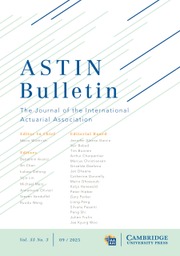No CrossRef data available.
Article contents
A maximum likelihood approach for uncertain volumes in the additive reserving model
Published online by Cambridge University Press: 12 February 2025
Abstract
The additive reserving model assumes the existence of volume measures such that the corresponding expected loss ratios are identical for all accident years. While classical literature assumes these volumes are known, in practice, accurate volume measures are often unavailable. The issue of uncertain volume measures in the additive model was addressed in a generalization of the loss ratio method published in 2018. The derivation is rather complex and the method is computationally intensive, especially for large loss development triangles. This paper introduces an alternative approach that leverages the well-established EM algorithm, significantly reducing computational requirements.
Keywords
- Type
- Research Article
- Information
- Copyright
- © The Author(s), 2025. Published by Cambridge University Press on behalf of The International Actuarial Association


